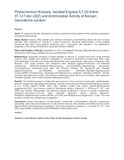Phytochemical Analysis, Isolated Ergosta-5,7,22-triene-3?,14?-diol (22Z) and Antimicrobial Activity of Kenyan Ganoderma lucidum

View/
Date
2021-02-06Author
Baraza, Danstone Lilechi
Ooko, Selline
Nyongesa, Peter Kuloba
Sande, Ebrahim
Metadata
Show full item recordAbstract
Aims: To screen the Kenyan Ganoderma lucidum for phytochemicals, determine the chemical composition and antimicrobial activity.
Study Design: Hexane, ethyl acetate and methanol extraction; phytochemical study and anti-microbial activities were analysed on Kenyan G. lucidum mushroom. Structural determination of the isolated compound was done using spectral evidences and in comparison with literature. The antibacterial properties of the compound was done using disc diffusion method.
Place and Duration of Study: Department of Pure and Applied Chemistry, Masinde Muliro University of Science and Technology, between January and November, 2019.
Methodology: Sequential extraction of dried samples of Kenyan G. lucidum were done using solvents hexane, ethyl acetate and methanol. Separation of extracts of Ganoderma lucidum was done using chromatographic methods and compounds determined using spectroscopic data and in comparison with literature. The crude extracts and compound were assayed against Escherichia coli, Klebsiella pneumoniae, Methicillin-Resistant Staphylococcus aureus (MRSA), Pseudomonas aeroginosa, and Criptococcus neoformans using agar well diffusion method. The compound was assayed against Escherichia coli, Klebsiella pneumoniae, Methicillin–Resistant Staphylococcus aureus (MRSA), Pseudomonas aeruginosa and Streptococcus pyogenes. Standard antibiotic namely; ampicillin was used as the control. Disc diffusion method was used and zones of inhibition, after respective incubation periods, were used to quantify antibacterial activity.
Results: The following group of compounds were present in the mushroom; terpenoids, carbohydrates, phenolic compounds, glycosides and polyoses. Hexane and methanol extracts showed significant activity at (p= 0.022) against MRSA while ethyl acetate extract was active against Streptococcus pyogenes (p=0.05). From hexane extract of Ganoderma lucidum, Ergosta-5, 7, 22-triene-3?, 14? – diol (22Z) was isolated. Ethylacetate and methanol extracts produced a mixture of complex compounds. Ergosta-5,7,22-triene-3?,14?-diol (22Z) exhibited significant activity against Methicillin-Resistance Staphylococcus aureus (MRSA) (p=0.022) and Streptococcus pyogenes (p = 0.05). The most sensitive microbe was Streptococcus pyogenes.
Conclusion: Kenyan Ganoderma lucidum contains terpenoids, carbohydrates, phenolic compounds, glycosides, flavonoids and phytosterols. Crude extracts (hexane, ethyl acetate and methanol) were active against MRSA and Streptococcus pyogenes. One major compound, Ergosta-5, 7, 22-triene-3?, 14? – diol (22Z) was isolated, characterized and antibacterial activity determined.
URI
https://doi.org/10.9734/bpi/cpcs/v7/2178Ehttps://stm.bookpi.org/CPCS-V7/article/view/49
http://ir-library.mmust.ac.ke:8080/xmlui/handle/123456789/1924
Collections
- Journal Articles [411]
